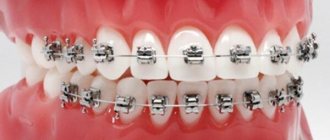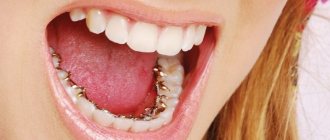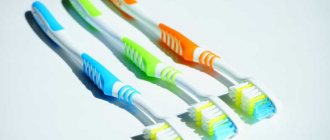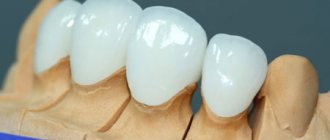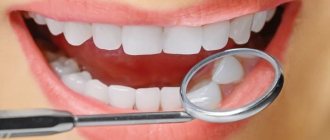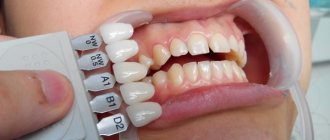Approximately every second adult needs orthodontic treatment. At the same time, not every one of them can afford to wear vestibular braces, located on the outer surface of the teeth. For some, this is caused by the professional need to always look impeccable; for others, the unaesthetic design does not fit in with the high requirements for their own appearance. In both cases, a lingual brace system, hidden from human eyes on the inner surface of the teeth, will help correct the position of the dentition.
The mechanism of action of the lingual structure is no different from the standard one. The differences affect a number of day-to-day features of adaptation and care of the system. Internal braces also have locks and a power arc, which puts pressure on the teeth necessary to gradually move them in the desired direction. The timing of correction with lingual braces is the same as when using external structures. All this, along with the ability to maintain an ideal appearance, determines the popularity of lingual systems among people who, due to their occupation, often have to be in public - representatives of show business, announcers and speakers, top managers, etc.
Along with the standard design, partial lingual braces can be used. They are installed in cases where there is one or a pair of crooked teeth on the jaw and there is no need to correct an entire row of teeth.
What are lingual braces, indications for installing lingual braces
Lingual braces are orthodontic structures designed to correct various malocclusion defects and are installed on the inner surfaces of the teeth, on the tongue side. This feature of lingual braces has made them especially popular among adult patients, since adults are embarrassed to wear classic braces, which are clearly visible on the surfaces of the teeth when communicating with others. Indications for the installation of lingual braces will be similar to the use of traditional braces, that is, they can be used to eliminate a wide variety of malocclusion defects.
Peculiarities
Win lingual braces are one of the methods of teeth straightening and bite correction used in aesthetic orthodontics. Such modern structures are made from an impression, taking into account the individual characteristics of the patient’s dentofacial system. With this approach, others will not notice that you are undergoing orthodontic treatment using braces.
This system is manufactured taking into account the characteristics of each patient’s tooth, which makes it possible to treat even complex dental anomalies. They are comfortable, practical, and do not rub your cheeks and lips.
What are the advantages of lingual braces?
The main advantage of lingual braces is their absolute invisibility, thanks to which the orthodontic treatment process can be carried out without strangers knowing about it. This is convenient for adult patients and for public, famous people who are constantly in society, at various events, and leading an active life on social networks.
Installation of lingual braces will not lead to disruption of the aesthetics of the smile and this is the main reason for the increased demand for lingual braces in adult patients. Statistics show that 70% of adults refuse orthodontic treatment precisely because they are embarrassed to wear braces on their teeth. If you have been putting off correcting your bite for this reason, you should get a detailed consultation on lingual braces from the orthodontists of our dental clinic in Moscow - “VENSTOM”.
Another significant advantage of lingual braces is a higher percentage of safety when used in patients involved in active and contact sports. Lingual braces can be used to correct the bite of musicians who play wind instruments. Also, installing lingual braces can reduce the risk of developing caries on the front surfaces of the teeth, which is of fundamental importance for the aesthetics of the smile area. After all, it is known that treatment of caries of the front teeth, even if carried out using modern technologies and materials, still worsens their appearance.
But in addition to the advantages, lingual braces also have disadvantages, of which there are many more, and you should definitely learn about the disadvantages of this type of orthodontic structures even before making your final choice in favor of lingual braces.
Indications and contraindications
Can everyone have such orthodontic structures installed? Almost everyone can install them; there is a list of contraindications, but it is small.
Indications for use:
- Correction of various malocclusions.
- Correction of irregularities in the dentition, including displacement, crowding or rotation of teeth around their axis.
- Solving the problem of a patient with high aesthetic requirements for treatment.
The main contraindications include:
- Small dental crowns.
- Severe forms of gum or periodontal disease.
- Childhood.
- Chronic diseases with severe course.
Only an orthodontist after a complete examination can recommend installation for incorrect position of teeth or malocclusion.
Sign up for a consultation
Disadvantages of lingual braces that you need to know before starting treatment
Lingual braces seem to be the best option for those people who would not like to advertise their treatment to strangers. However, it is important to take into account that lingual braces have a number of very noticeable disadvantages in comparison with classic braces. Let's take a closer look at all the disadvantages of lingual braces.
Long adaptation period and pain at the beginning of treatment
A significant disadvantage of lingual braces is the long period of adaptation to the installed structures. Moreover, you need to prepare for the fact that during the period of getting used to lingual braces you will be bothered by quite painful sensations. Note that in terms of the level of pain that occurs during the adaptation period, lingual braces have the highest rates (in comparison with classic braces and aligners). An orthodontist should definitely warn you about these disadvantages of lingual braces at the stage of planning a course of treatment.
Negative impact on diction
At first, after installing lingual braces, severe diction problems may occur. This negative side effect of use in the correction of malocclusions is explained by the fact that braces are attached to the teeth from the side of the tongue, an organ actively involved in speech. Disorders of diction when wearing lingual braces are eliminated by performing special exercises.
Tongue injury
Installing lingual braces on the inner surfaces of teeth often leads to injury to the tongue, which will touch parts of the brace system when speaking and eating. The tongue is especially often injured by elements of the brace system during the period of adaptation to lingual braces.
Longer treatment periods
Another significant disadvantage of lingual braces is the longer treatment period (compared to the duration of the course of correction with classic braces).
Therefore, if you quickly want to solve the problem of malocclusion and get straight teeth, lingual braces are unlikely to suit you. Finally, it is worth knowing that treatment with lingual braces will be expensive, much more expensive than correction with aligners or traditional braces. The high price of treatment with lingual braces is explained by the fact that such structures themselves have a high cost, are produced abroad (some types), and in addition, the treatment process will also be quite labor-intensive.
In what cases are internal braces not used?
For a number of clinical cases, invisible braces are the best treatment option. For example, lingual braces for deep bites work much more effectively than vestibular braces. However, there are a number of restrictions under which it is better not to place lingual braces on teeth. Among them:
- periodontal diseases;
- low dental crown;
- dysfunction of the temporomandibular joint;
- allergy to the materials from which the system is made;
- bruxism;
- too narrow jaw;
- severe crowding of teeth;
- age under 11 years.
Free consultation on the cost of treatment in our dentistry
Leave a request and the clinic administrator will contact you within 15 minutes!
IMPORTANT: some clinics may not tell you about another and quite significant disadvantage of lingual braces - how they can affect a person’s personal, intimate life. When using lingual braces, when kissing a loved one, the partner's oral mucosa may be injured by the elements of the braces, which is both painful and dangerous due to the introduction of infections into the wounds. The doctors of our dental clinic in Moscow - “VENSTOM” honestly tell their patients about all the nuances of treatment with different types of braces!
What to choose
Each of the described brace systems allows you to effectively combat malocclusion, both mild and complex types. As for the choice, it is difficult to single out just one type of design. There are a number of factors that need to be taken into account, one of which is price.
If you adhere to the opinion of doctors, then they recommend sapphire and ceramic braces that are not visible. But objectively, lingual products are the best. Despite the fact that they have a very high cost, today they are preferred by those patients who are constantly in contact with people. If what is more important to you is not appearance, but convenience, then you should opt for sapphire designs.
How are lingual braces made and installed?
The manufacturing process for lingual braces will depend on which brand you choose to correct malocclusions. For example, quite popular “incognito” lingual braces are produced by computer modeling using CAD/CAM technology and are manufactured in Germany, in the brand’s laboratory.
Having chosen this brand of lingual braces, you should be prepared for the fact that before treatment you will have to wait quite a long time for the braces to be made and sent to the clinic in Russia. This process may take several months. There are also simpler types of lingual braces, which are made from an impression of the teeth. In this option, the installation system will be made faster.
You need to know that before installing lingual braces, it is imperative to properly prepare the oral cavity. Neither lingual nor classic braces can be installed on teeth with carious lesions, so treatment must be carried out before fixing braces. Treatment will also be required if the patient has pulpitis, periodontitis, or gum inflammation.
Even if the teeth are healthy, before installing lingual braces, it is mandatory to sanitize the teeth and oral cavity. It allows you to remove plaque from your teeth and thereby reduce the risk of developing caries under installed braces.
The next stage in treatment is taking impressions and making lingual braces. When the braces are ready, you will be invited to the dentist to install the braces. This process will include the following sequential steps:
- Cleaning the enamel coating of teeth from the inside. This procedure is necessary to improve the fixation of braces on dental surfaces;
- The plates of lingual braces with fasteners are glued onto the prepared dental surfaces;
- An arch is inserted into the grooves on the bracket plates and then firmly fixed in a certain position using fasteners.
At this point, the installation of lingual braces ends and the orthodontist advises the patient in detail on the care of the oral cavity during the course of treatment with braces. The next visit to the clinic is also scheduled, during which the orthodontist will evaluate the results of treatment and, if necessary, correct the position of the arch.
During the treatment of a bite with braces, you will have to make regular visits to the clinic until the end of the full course. Typically, patients with lingual braces visit the doctor once every 1.5 months.
Calculate the cost of treatment by taking a short test in 20 seconds!
Do not delay your treatment, because in this matter time plays against us.
How long should I wear invisible braces?
On average, correcting a malocclusion with lingual braces takes about 12-18 months.
Lingual invisible braces: reviews
Semyon
I'm incredibly pleased with the result! I installed a brace system, which I got through in about a year and a half. The clinic provides a full range of procedures for effective bite alignment - regular examinations and arch adjustments, installation of the system itself, as well as replacement of a separate bracket if it breaks (this happened to me, they replaced it without any problems). You should not be afraid of the process of correcting your bite with braces - this is a very good and not unpleasant way to correct imperfections in the position of your teeth. The process is long, but you get straight teeth, thanks to which not only your smile, but your entire face is transformed (this is especially good when directly comparing before/after photographs. Photos are taken during the treatment process and at the end are sent in the form of a presentation. It immediately becomes clear that everything was not in vain). If you have any doubts about whether to get braces or not, do so, it’s worth it! BELGRAVIA DENTAL STUDIO TEAM:
Simon, thank you very much for sharing your experience! You did the right thing by deciding to get braces. We wish you good health and many reasons to smile!
Semyon
I'm incredibly pleased with the result! I installed a brace system, which I got through in about a year and a half. The clinic provides a full range of procedures for effective bite alignment - regular examinations and arch adjustments, installation of the system itself, as well as replacement of a separate bracket if it breaks (this happened to me, they replaced it without any problems). You should not be afraid of the process of correcting your bite with braces - this is a very good and not unpleasant way to correct imperfections in the position of your teeth. The process is long, but you get straight teeth, thanks to which not only your smile, but your entire face is transformed (this is especially good when directly comparing before/after photographs. Photos are taken during the treatment process and at the end are sent in the form of a presentation. It immediately becomes clear that everything was not in vain). If you have any doubts about whether to get braces or not, do so, it’s worth it! BELGRAVIA DENTAL STUDIO TEAM:
Simon, thank you very much for sharing your experience! You did the right thing by deciding to get braces. We wish you good health and many reasons to smile!
About the price of bite correction with lingual braces
The price of bite correction with lingual braces will largely depend on the type of structure and its manufacturer. Therefore, it is impossible to name the exact cost of treatment in absentia - you need to visit an orthodontist, undergo diagnostics, decide on the type of braces, and then the specialist will draw up for you a detailed plan of the treatment course, which will indicate the exact and final prices for all the necessary procedures.
The average cost of bite correction with lingual braces in Moscow ranges from 100 to 400 thousand rubles. It is worth keeping in mind that the indicated amount does not include the costs of scheduled examinations at the orthodontist’s office during the course of treatment, as well as the cost of removing braces and subsequent installation of retainers, the wearing of which secures the achieved positive result.
Price
Installation of internal devices is more expensive than vestibular ones - manufacturing is more complicated; ready-made structures are required to be shipped from Germany. In addition, gold-containing alloys are used, which increases the cost.
We offer treatment in installments in 3 stages:
- 1. Teeth cleaning, braces, manufacturing and installation are paid for.
- 2. Correction costs.
- 3. Removing the system.
Retention devices (aligners or retainers) are paid separately after completion of the main treatment.
Are there alternatives to lingual braces?
If you want to treat bite defects, but lingual braces are not suitable for you - due to the high price, a large number of disadvantages or for other reasons - in our dental clinic "VENSTOM" they can always offer you a worthy alternative - for example, aligners, mouth guards or classic braces made of aesthetic materials, invisible on tooth surfaces.
Come to VENSTOM and we will definitely help you get a beautiful smile by choosing the type of braces that suits you in terms of characteristics, aesthetics and, of course, price and treatment time.
Features and advantages of vestibular aesthetic systems
Vestibular braces are installed on the outside of the teeth. This fixation method is classic. The use of translucent ceramics for the manufacture of bracket plates makes the standard design less noticeable; it does not change the aesthetics of the appearance.
Ceramic braces are more expensive than the classic version of corrective devices, but cheaper than lingual braces. Therefore, “invisible” ceramics are the golden mean when evaluating them in terms of monetary costs.
Price
If we consider the price factor, then the price for invisible berects is ambiguous. When compiling it, a number of factors are included. If we talk about the most expensive and elegant products, then sapphire ones, which have a thin platform. Each platform is tailored to the individual tooth shape. Thanks to modern technologies that are actively used for the production of invisible braces, it is possible to obtain high precision, and the effectiveness of therapy can be predicted in the first stages. The cost of invisible braces in Russia is 80,000–15,000 rubles.
Installing braces is a necessary procedure, thanks to which it is possible to solve all problems associated with incorrect teeth and bite. The best option would be to install invisible structures that allow you to feel comfortable both while talking and eating.
Sources used:
- National Library of Medicine (USA)
- "Orthodontics. Textbook for dentists" (Kutsevlyak V.I.)
- Agadzhanyan, E.G. Notes of a good dentist / E.G. Aghajanyan. - M.: Omega, 2011.
